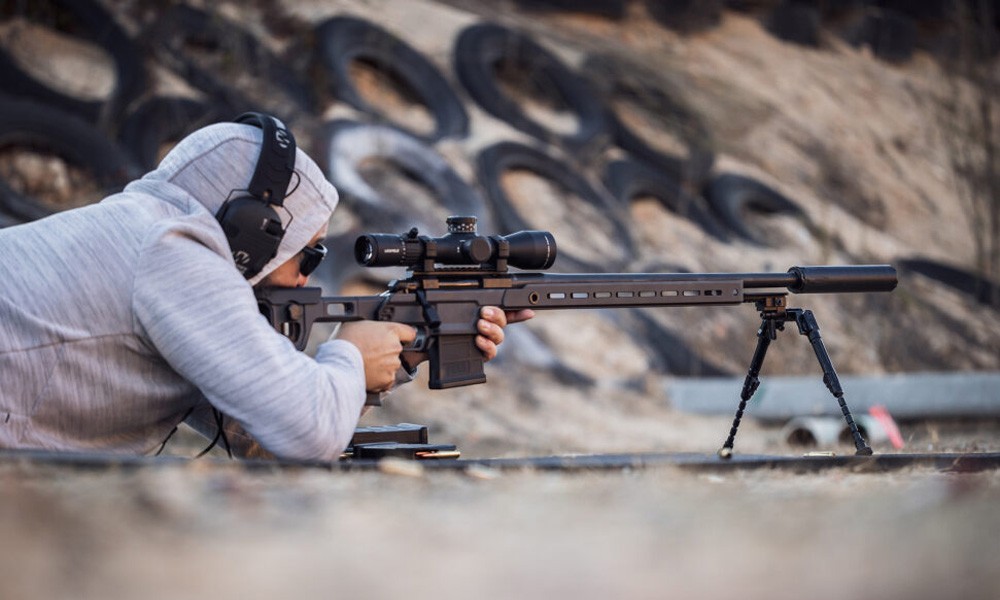- Velocity Increase with Suppressors: Attaching a suppressor to a firearm generally results in a velocity increase of 10 to 60 FPS, depending on factors like cartridge type, barrel length, and suppressor design. This can result in higher muzzle energy and extended effective range.
- Impact on Ballistics: Suppressors boost bullet speed and slightly alter the ballistic curve, making trajectories flatter. This adjustment can significantly influence long-range shooting accuracy, impacting factors such as hold-over at a distance.
- Practical Benefits: Adding a suppressor can increase speed, providing the benefits of a longer barrel without the added length or weight. This can be particularly beneficial in maintaining a compact firearm setup while enhancing precision and long-range shooting performance.
Table of Contents
Do Suppressors Increase Velocity?
Yes, suppressors do increase bullet velocity. Attaching a suppressor to your barrel allows more time for the combustion gases to act upon the bullet and propel the projectile with greater force.
How much velocity do you gain with a suppressor? Most firearm and suppressor combinations will see a 10-60 feet per second (FPS) velocity increase. The added velocity depends on the cartridge, barrel length, and suppressor.
How Much Velocity Does a Suppressor Add?
Suppressors will add around 30-50 FPS on most guns. The amount that the velocity increases will depend on the specific setup, including the caliber, barrel length, and suppressor.
Slower-moving calibers such as 9mm, subsonic 300BLK, or 45ACP will usually see smaller velocity increases, generally 10-30 FPS gains.
Faster-moving rounds like 5.56, 6.5 Creedmoor, and .308 Winchester will generally see larger bumps, 30-60 FPS.
More testing is required to determine how different suppressor designs influence velocities, and it is unclear whether high back pressure or low back pressure suppressors add more speed to your projectiles.
If you want more velocity testing, let us know in the comment section.


Does a Suppressor Increase Muzzle Velocity?
Yes, silencers will increase muzzle velocity on most common centerfire cartridges.
The common rule of thumb is that a rifle will gain about 25 FPS per inch of added barrel length, so adding a suppressor to your 6.5 Creedmoor, is equivalent to adding about two inches of barrel length.
The added velocity of a silencer can allow you to use a slightly shorter gun, to keep your loadout as compact as possible while still enjoying the benefits of shooting suppressed.
Snipers fielding the legendary M110 SASS (Semi-Automatic Sniper System) noted that the gun's effective range was about 850 yards with the included flash hider. However, attaching a suppressor to a 20" .308 firearm helped make hits more consistently out to 1000 yards due to increased muzzle velocity.
How Do Suppressors Affect Ballistics?
Suppressors add velocity to projectiles, which allows them to carry more speed and to travel further, increasing effective range and resulting in a slightly flatter ballistic curve.
We ran a simulation in the Applied Ballistics Mobile App to see how adding a suppressor would change ballistic data and energy.
Our data was based on a 24" 6.5 Creedmoor firing a 147-grain Hornady ELDM at 2750 FPS, a common combination for use in precision rifle competitions and long-range shooting. This resulted in a muzzle energy of 2455 ft-lbs, 2214 ft-lbs at 100 yards, and an 8.6 Mil hold-over at 1000 yards.
Equipping a suppressor to the same virtual rifle setup added 50 FPS; keeping everything else the same, we ran the same calculations. This time, the suppressed rifle had a muzzle energy of 2551 ft-lbs, 2306 ft-lbs at 100 yards, and an 8.2 Mil hold-over at 1000 yards.
That is a pretty significant change at range. A .4 mil hold can easily be the difference between an impact and a miss.
The suppressed rifle also had ~4% more energy at the muzzle and at 100 yards; while small, it's not insignificant. Most hunters agree that 1000 ft-lbs of energy is ethical to take down a whitetail deer. The unsuppressed rifle crosses below that energy level at 745 yards. The suppressed gun extends that range to just over 800 yards before dipping into the 900s.


Conclusion
Using a suppressor on a firearm can offer tremendous benefits beyond noise reduction.
By increasing the bullet's velocity, suppressors enhance muzzle energy and potentially extend the firearm's effective range. These changes result in more efficient long-range shooting with flatter trajectories and better energy retention at distance.
Adding a suppressor can significantly improve firearm performance for competitive shooting, hunting, or tactical applications, making it a worthwhile consideration for those looking to optimize their shooting capabilities.





